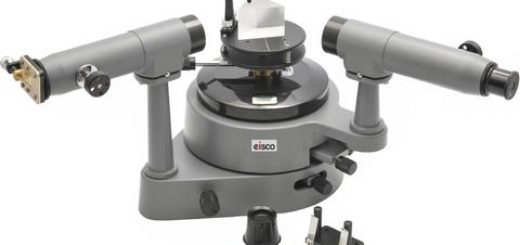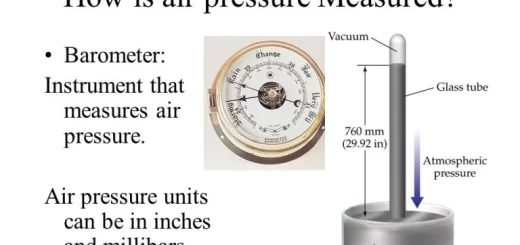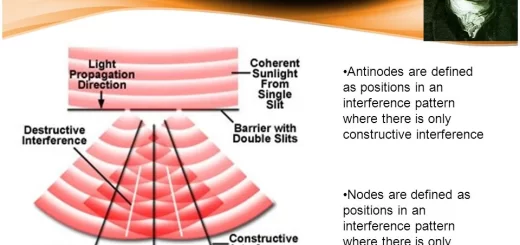The magnetic field due to current in a circular loop and a solenoid
The magnetic flux lines emerge from the North pole to the South pole outside the coil, A circular loop carrying an electric current is like a magnet in the form of a disk has 2 circular poles such that no individual poles exist in nature but always pole pairs, North and South poles.
Magnetic field due to current in a circular loop
The shape of the magnetic flux lines: To identify the shape of the magnetic lines, carry out the following steps:
- Spread iron filings on a board surrounding a circular loop carrying electric current.
- Tapping it gently, the iron filings arrange themselves.
Observation :
- The flux lines near the center of the loop are no longer circular.
- The magnetic flux density changes from point to point.
- The magnetic flux lines at the center of the loop are straight parallel lines perpendicular to the plane of the coil.
Conclusion :
- The magnetic field due to a current in a circular loop is similar to the magnetic field of a short magnet.
- The magnetic field at the center of the coil is uniform so, the magnetic field lines are parallel and perpendicular to the plane of the coil.
Right-hand screw rule
Uses: It is used to determine the direction of the magnetic flux at the center of the circular loop carrying an electric current.
Method: Imagine a right-hand screw (being) screwed to tie along the wire in the direction of the current, the direction of fastening of the screw gives the direction of the magnetic flux at the center of the loop.
The clockwise direction rule
Uses: It is used to determine the type of pole for each face of a circular loop carrying an electric current.
Method: The side which carries an electric current in the clockwise direction is called the South pole, The side which carries an electric current in the counterclockwise direction is called North pole.
Deduction of the magnetic flux density
The magnetic flux density at the center of a circular loop of the radius (r), number of turns (N) and carrying electric current (I) can be deduced as follows:
B ∝ N, B ∝ I, B ∝ (I / r)
B ∝ N I / r, B = Constant × N I / r
B = μ N I / 2 r
The factors that affect the magnetic flux density at the center of a circular loop
- The number of turns of the circular loop (N) is directly proportional.
- Electric current intensity (I) is directly proportional.
- The permeability of the medium (μ) is directly proportional.
- The radius of the circular loop (r) is inversely proportional.
Determination of the number of turns of a circular loop:
- If a wire of a length (L) is coiled in the shape of a circular loop of a radius (r): Therefore, N = L / 2 π r, Where: N is either integer or not an integer number.
- If the coil is an incomplete part of a circle, then: N = θ / 360
In case of changing the number of turns of the circular loop from N1 to N2 and connecting it with the same source.
B1 / B2 = N1 r2 / N2 r1
∴ N1 / N2 = r2 / r1
B1 / B2 = N1² / N2² = r2² / r1²
To determine the magnetic flux density at the center of a circular loop at a certain distance from a straight wire in the same plane while an electric current is passing through each of them.
If the field of each of the wire & the coil in the same direction, Therefore:
Bt = Bcoil − Bwire
If the field of each of the wire and the coil in opposite directions, Therefore:
Bt = Bcoil − Bwire, ( Bcoil > Bwire), Bt = Bwire − Bcoil, (Bwire > Bcoil).
In the case of a circular loop tangent to a straight wire causing the magnetic flux density to vanish at the center.
Bcoil = Bwire , μ I1 N / 2r = μ I2 / 2πd
N I1 = I2 / π
In case of two circular loops having the same center and carrying two currents:
In the same direction then the resultant of the flux density at the center.
Bt = B1 + B2
In the opposite direction then the resultant of the flux density at the center.
Bt = B1 − B2 , ( B1 > B2 ).
In case of two circular loops having the same center and perpendicular to each other: Bt² = B1² + B2²
Magnetic field due to current in a solenoid
The shape of the magnetic flux lines
When the electric current passes through the solenoid (along a spiral or cylindrical coil), the resultant magnetic flux is very similar to that of the bar magnet, The magnetic flux lines make a complete circuit inside and outside the coil, each line is a closed path.
Right-hand screw rule
Uses: It is used to determine the direction of the magnetic flux at the axis of a solenoid passing through it an electric current.
The method: As mentioned previously in the circular loop considering that the solenoid consists of a group of circular loops having the same center.
The clockwise direction rule
Uses: It is used to determine the type of pole for each side of a solenoid carrying an electric current.
Method: As in the circular loop.
Amper’s right-hand rule
Uses: It is used to determine the polarity of the field.
Method: When you grasp the coil with your right hand such that the fingers point to the direction of the current, the thumb points to the direction of the magnetic field due to the current.
Deduction of the magnetic flux density
Deduction of the magnetic flux density at any point of a solenoid of length (l) and its number of turns (N) carrying an electric current (I) is as follows:
B ∝ N, B ∝ I, B ∝ I / L
B = Constant × N I / L
B = μ N I / L = μ n I
n = N / L
Where: (n) is the number of turns for unit length of the solenoid, When the number of turns are touching each other along the length of the solenoid, then the length of the coil: L = N × 2 r¯, Where: (r¯) is the radius of the wire of the coil.
The factors that affect the magnetic flux density due to current in a solenoid
- The number of turns of the coil (N) is directly proportional.
- Electric current intensity (I) is directly proportional.
- The permeability of the different media is directly proportional.
- The length of the coil is inversely proportional.
The magnetic field may not be generated when the electric current passes in a circular loop or a solenoid, because the circular loop or the solenoid is double-coiled, so the direction of the produced magnetic flux due to the flow of the current in a certain direction becomes opposite to that produced due to the flow of the same current in the opposite direction and thus they cancel each other.
If a part of a coil connected to the electric source is cut, then the remaining part of the coil when connected to the same source:
- Its current increases.
- The number of turns decreases.
- The length of the coil decreases.
- Number of turns/unit length remains constants.
When the turns of the coil are touching each other, then the length of the coil: L = N × 2 r¯, Where: (r¯) is the radius of the wire in the coil.
In case of two solenoids, having the same axis and carry two currents:
In the same direction, so, the resultant of the magnetic flux density at the axis center is Bt = B1 + B2.
In two opposite directions, so, the resultant of the magnetic flux density at the axis center is Bt = B1 − B2, (B1 > B2).
When turns of the circular loop are moved away from each other, the loop becomes a solenoid and can be compared based on the relation.
Bcircular − Bsolenoid = Lsolenoid / 2 rcircular
Magnetic effect of the electric current & Magnetic flux density due to current in two parallel wires
Magnetic force & Torque, Factors that affect the torque & magnetic dipole moment



